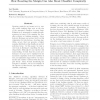Free Online Productivity Tools
i2Speak
i2Symbol
i2OCR
iTex2Img
iWeb2Print
iWeb2Shot
i2Type
iPdf2Split
iPdf2Merge
i2Bopomofo
i2Arabic
i2Style
i2Image
i2PDF
iLatex2Rtf
Sci2ools
ICML
2006
IEEE
2006
IEEE
How boosting the margin can also boost classifier complexity
Boosting methods are known not to usually overfit training data even as the size of the generated classifiers becomes large. Schapire et al. attempted to explain this phenomenon in terms of the margins the classifier achieves on training examples. Later, however, Breiman cast serious doubt on this explanation by introducing a boosting algorithm, arc-gv, that can generate a higher margins distribution than AdaBoost and yet performs worse. In this paper, we take a close look at Breiman's compelling but puzzling results. Although we can reproduce his main finding, we find that the poorer performance of arc-gv can be explained by the increased complexity of the base classifiers it uses, an explanation supported by our experiments and entirely consistent with the margins theory. Thus, we find maximizing the margins is desirable, but not necessarily at the expense of other factors, especially baseclassifier complexity.
| Added | 17 Nov 2009 |
| Updated | 17 Nov 2009 |
| Type | Conference |
| Year | 2006 |
| Where | ICML |
| Authors | Lev Reyzin, Robert E. Schapire |
Comments (0)

